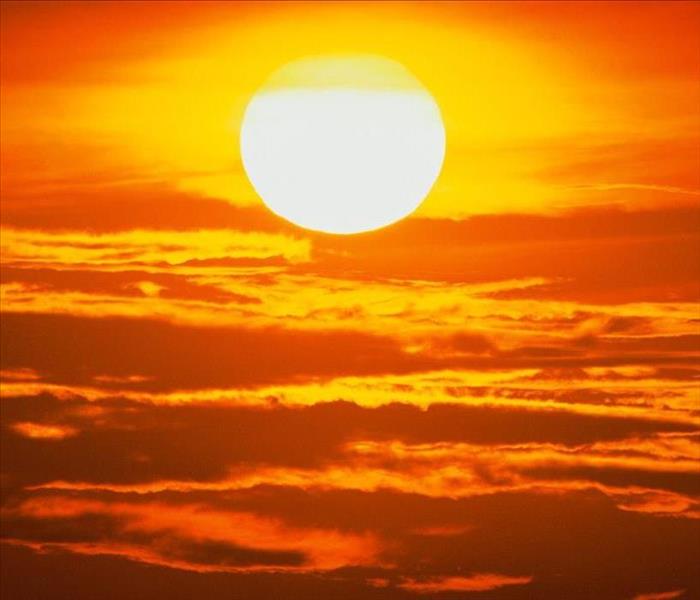Archived Fire Damage Blog Posts
Hassle Free Holidays
10/17/2022 (Permalink)
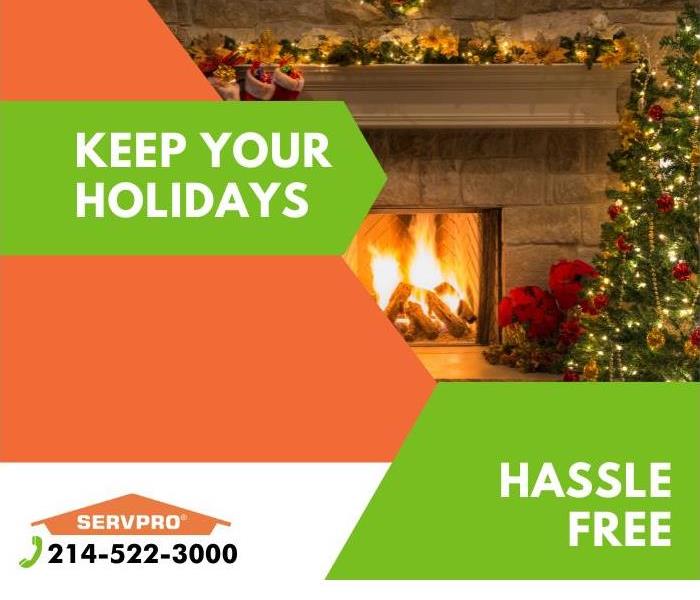 Practice fire safety and keep your holidays hassle free.
Practice fire safety and keep your holidays hassle free.
As we head into holiday season, the temperature drops and we start to spend more time indoors. We decorate with lights, cook big meals, burn fall scented candles and eventually turn on the heater when it gets cold enough. These things increase our holiday spirit – but they also increase the chance of a home fire.
We’ve got some winter wisdom for you to stay safe from fire:
Heed the Heaters:
- If using portable heaters, make sure they are in good working order with no frayed cords.
- Place them at least 3 feet away from anything combustible, such as paper, clothing or blankets.
- Don’t leave them on when you leave home alone or while you sleep – heaters should always be monitored.
Contain the Candles:
- Keep candles in sturdy containers that cannot be easily knocked over and make sure the flame isn’t close to something that could ignite.
- Never leave a candle unattended and make sure to extinguish them before leaving the room.
- Consider using battery operated candles to reduce your risk even further.
Tend the Tree:
- If you put up a live Christmas tree, make sure you keep it well watered at all times.
- Always unplug lights when not in use, or have them set up on a timer to automatically turn off.
- Keep trees away from heat vents and other heat sources.
- Make sure your tree stand can hold your tree securely so that it doesn’t fall.
Preventative measures such as having your chimney inspected and making sure your smoke detectors are working are also important winter prep-steps.
If you experience a fire at your home this winter call SERVPRO of Park Cities anytime at 214-522-3000.
Avoid Turkey Troubles
10/17/2022 (Permalink)
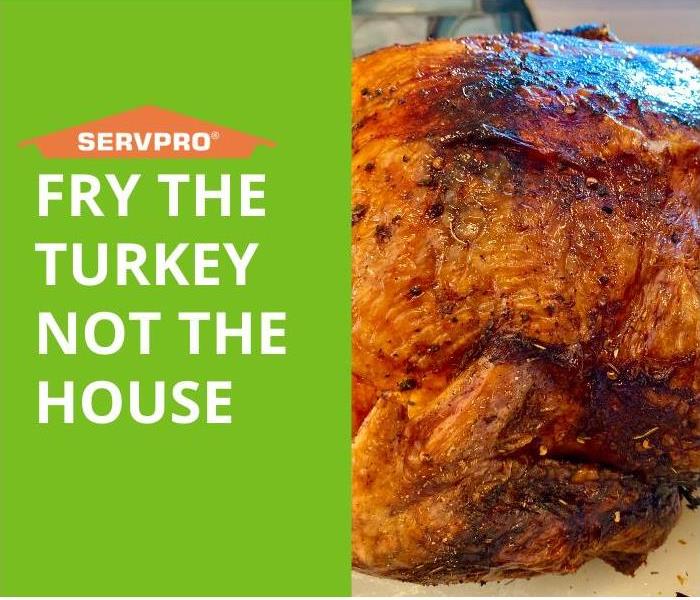 Deep fryers can make things delicious, but also dangerous.
Deep fryers can make things delicious, but also dangerous.
Who doesn't love a deep friend turkey? You might think this is an easy DIY - but failed fryers are one of the most common sources of fire damage throughout the fall.
Here are some tips to keep your turkey trouble-free.
- Don't Use Too Much Oil- Even a small amount of oil can catch flame if it comes into contact with a burner. If the pot is too full, oil can spill when you insert the turkey. The U.S. Fire Administration suggests that you first place the turkey in a pot with water so you will know the correct amount of oil.
- Don’t Leave a Fryer Unattended– deep fryers may not have thermostat controls and can overheat to the point of combustion. It’s crucial to stay close and to check the temperature of the oil often. Deep Fat Fryers are also easy to tip over – so make sure the area is secure and monitored.
- Never Use a Fryer Inside– these should always be used outdoors on a solid surface (not a deck or under a patio cover.)
- No Frozen Turkeys in the Fryer- Make sure you thaw your turkey completely prior to cooking. When a frozen turkey comes into contact with high temperature oil it causes lots of steam. The steam can make the oil boil over and catch fire.
- Keep a Fire Extinguisher & Pot Holders Nearby- make sure you have a fire extinguisher and well-insulated potholders nearby since the lid, sides and handles get insanely hot and you could end up with harsh burns if not careful.
- Keep Others Safe- never let children or pets near the fryer when in use or after use as the oil can remain hot for hours.
SERVPRO of Park Cities wishes you and your family a safe and happy Thanksgiving!
Merry & Bright
10/17/2022 (Permalink)
 Make sure you blow out candles and turn off lights.
Make sure you blow out candles and turn off lights.
Christmas items are already in stores and people are getting the decorating bug. As you start brightening up your home and yard, make sure you stay fire-safe. Here is some pre-winter wisdom to keep in mind:
Candles give a room a cozy vibe and smell delicious, but proper usage is key to keeping them safe. Be sure they are on a stable surface with plenty of ventilation and that they aren't near anything flammable such as dried flowers or paper decorations. Battery powered candles are also a great option!
If you love a live Christmas tree, you have to keep it well watered to avoid dry branches which can easily catch fire. It's also important to unplug the lights when not in use or have them set up on a timer to automatically shut off.
Before you get the fireplace going, have your chimney inspected and make sure your smoke detectors work. Don't let the fallen leaves pile up too much, especially if there is a dry spell.
We hope your holidays are hassle free, but should you experience any fire or smoke damage, SERVPRO of Park Cities is here to help. Call us at 214-522-3000.
Fire Stinks!
12/21/2021 (Permalink)
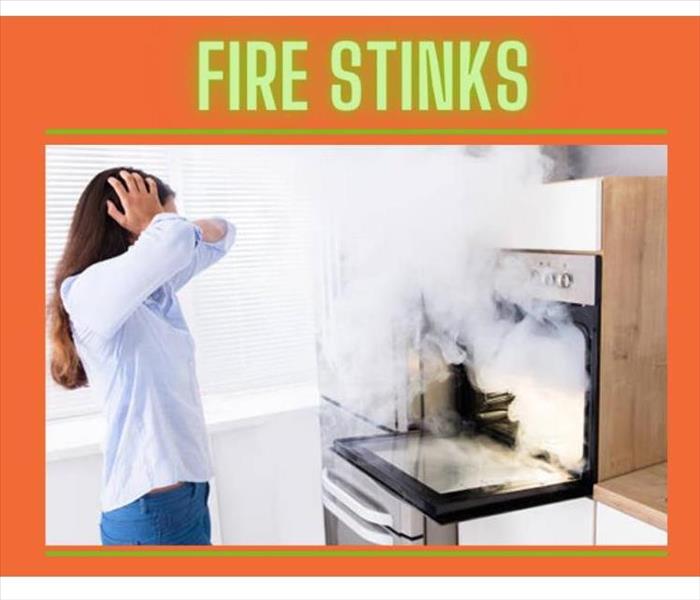 Putting the fire out is the first step - then you have to remove the odor of smoke!
Putting the fire out is the first step - then you have to remove the odor of smoke!
Recovering from fire damage has many layers and steps, so our fire mitigation team follows the protocols from the Institute of Inspection, Cleaning, and Restoration Certification (IICRC). Many people don’t know that there can be water and chemical residue from the firefighting and no matter how untouched your dwelling looks surface cleaning and damage restoration, the unmistakable odor of smoke and other combusted building materials can linger.
HVAC systems can spread and retain odor-bearing particles. If vents are open during the fire or fire residue cleaning efforts, the odors drift far from the origin site. Our goal is to eliminate the source of the odor (no matter how small the particles) rather than covering them up. Thermal foggers recreate the conditions of the fire to disperse heated chemicals that attach to the granular bits and neutralize the smell. We also use hydroxyl generators or ozone machines as another way to attack the odor problem at a molecular level. Enzymatic products can help with organic soiling and smells.
Rely on the team at SERVPRO of Park Cities to eliminate all evidence of fire damage – including (and especially) the smoky odors. We will do everything we can so that it looks and feels “Like it never even happened.”
Rare but Real
10/5/2021 (Permalink)
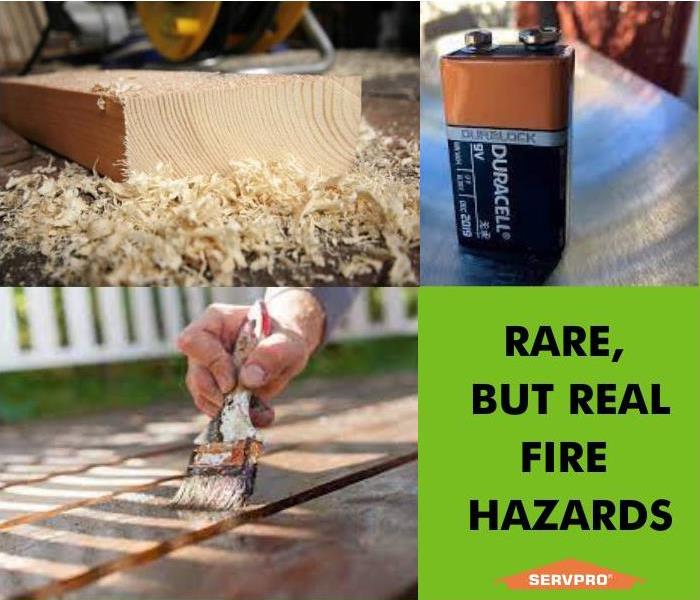 Know all the possible fire risks.
Know all the possible fire risks.
Did you know that accumulated lint in your dryer vent can cause a fire?
How about a phone battery or old dishwasher?
How about non-dairy coffee creamer?
True Story.
Here are a few rare but real fire-starters to be aware of:
1 – Recalled Appliances – take a look at the Consumer Product Safety Commission’s website (www.cpsc.gov/Recalls) to make sure your microwave or computer battery hasn’t been recalled.
2 – Excess Sawdust – if you’re a DIYer, then you may have sawdust on your work surfaces. Make sure to clean workspaces with a vacuum designed to collect combustible materials to avoid accumulating dust which is flammable.
3 – 9-Volt Batteries – all batteries should be disposed of safely, but especially the 9-Volts. These have been known to spark when in contact with metal while in a trash can or junk drawer.
4 – Linseed Oil – if you use this to polish your butcher block countertops or other wood furnishings, make sure you wash the rag immediately after use as they can spontaneously combust.
5 - And finally - that non-dairy coffee creamer, as well as other manufactured foods can combust if exposed to an open flame.
Fire is destructive whether caused by a common or rare situation. Please exercise caution and know your risks. Proper fire safety is everyone’s responsibility.
Fire Prevention Week is Oct 3 - 9
10/1/2021 (Permalink)
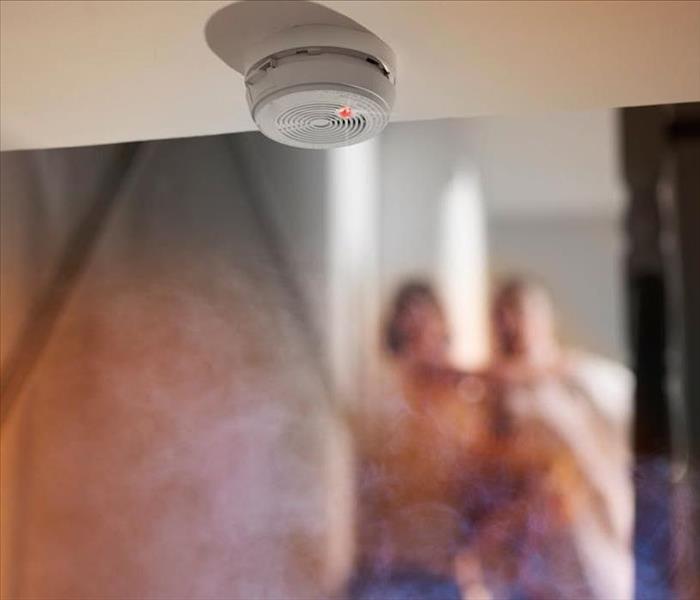 Three beeps in a repeating pattern means your alarm has detected smoke and/or fire.
Three beeps in a repeating pattern means your alarm has detected smoke and/or fire.
The National Association for Fire Prevention sponsors "Fire Prevention Week" each year, and this year they are focusing on "The Sounds of Fire Safety" You can learn more and access great resources for kids at their website but here are the main points they want us to HEAR:
If you hear a continued set of three loud beeps—beep, beep, beep - from your fire alarm, it means smoke or fire. Get out, call 9-1-1, and stay out.
If you hear a single “chirp” every 30 or 60 seconds, then your battery is low and needs to be changed. Chirping that continues after the battery has been replaced means the alarm is at the end of its life and the unit must be replaced.
Did you know that all smoke alarms must be replaced after 10 years?
You can find the official flier from the NFPA https://www.nfpa.org/fpw here for your convenience.
We hope you never hear those 3 beeps, but if it does happen - SERVPRO can help. We are the restoration experts in Park Cities and will help you navigate the entire process.
Delicious, not Dangerous
6/28/2021 (Permalink)
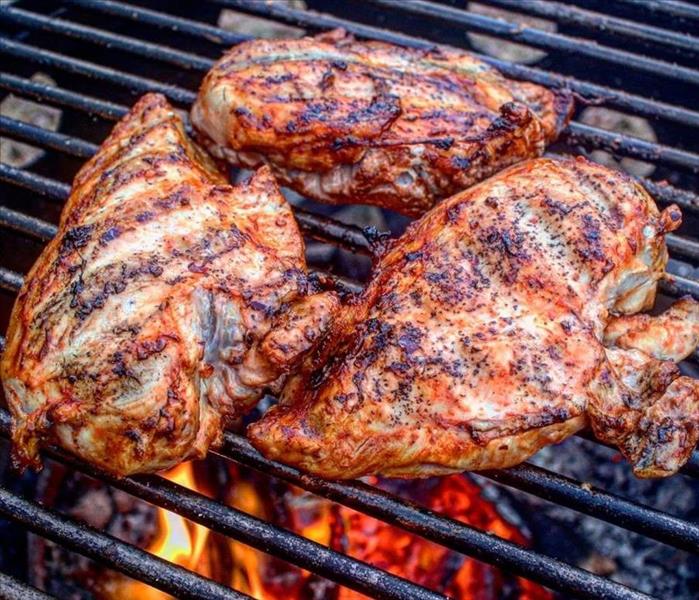 Summer grilling should be delicious, not dangerous.
Summer grilling should be delicious, not dangerous.
Summer is in full swing and if you’re like us – you’re grilling dinners to keep the heat outside. Well, we’ve got a few things to share to keep you safe and satisfied the next time you throw some chicken on the grill.
Keeping Safe:
- Make sure your grill is at a safe distance from the house and anything flammable – you never want to grill underneath an overhang or in the garage. Watch the wind as well – if you are grilling in a windy area, it can blow between the grates and fuel a flare up.
- Use tools with long handles to keep a safe distance from the flame, and avoid wearing any clothing items that may easily catch fire (i.e. long, baggy sleeves)
- Always clean a grill after use, while its still hot, with a wire brush to avoid accumulations of fatty, greasy materials. Food residue and old grease are both great fuel for a fire, so removing debris after each use is important. Don’t forget to check and empty any trays below the grill where grease collects.
- If you use lighter fluid to light a charcoal grill, only use charcoal starter fluid. Never add the fluid to a flame, add it before lighting the grill. Spraying water on fire can cause grease to explode – turn the burners off and use a fire extinguisher instead.
Keeping Satisfied
- Marinade your meat before grilling to make it tasty and can keep it from drying out. If you’re in a hurry – you can score the meat before you put it in the marinade. It’s best to leave it in the marinade for 2-6 hours depending on the type of meat. You can marinade overnight but be careful not to leave it too long as it can make the meat tougher.
- If you love spicy – then you must try this marinade we found at https://www.joyfulhealthyeats.com/the-best-5-flavorful-chicken-marinades-for-grilling/
Add the following to a bowl and whisk until combined. Then add chicken to a large storage bag and pour marinade over chicken. Let it sit for at least an hour before grilling.
- 3 tablespoons honey
- 1 tablespoon olive oil
- 1 tablespoon lime juice
- 3 teaspoons sriracha
- 1/4 teaspoon ground ginger
- 1/4 teaspoon smoked paprika
Let us know if you liked it - or drop a comment with your favorite grilling recipe below.
Keep Summer Safe!
Common Causes of House Fires
12/8/2020 (Permalink)
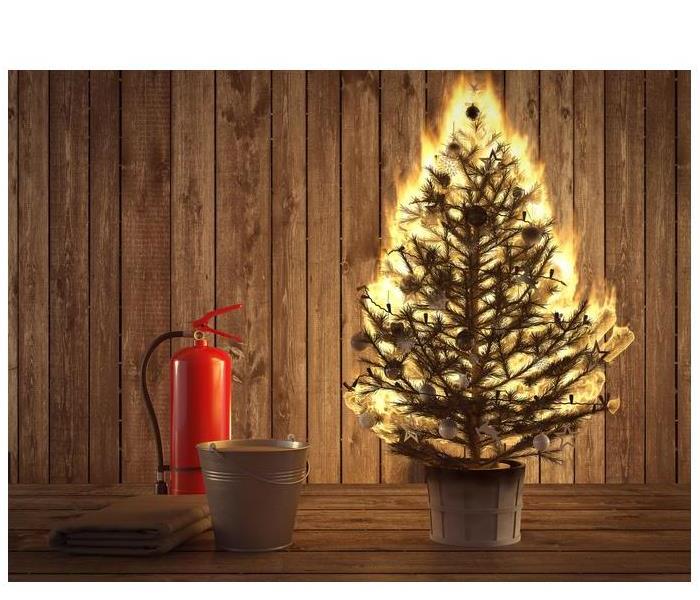 Holiday Decorations Can Be a Fire Risk.
Holiday Decorations Can Be a Fire Risk.
Fire is extremely volatile and can spread quickly if not responded to appropriately. According to the National Fire Protection Association (NFPA), fire departments in the United States must respond to home fires every 24 seconds. Don't let your home in Park Cities become part of that statistic. Here are the most common causes of house fires.
Cooking Fires
Cooktops generate open flames that can quickly spread out of control if they aren't watched carefully. Home cooking fires account for approximately $1 billion in property damage, 550 deaths and 4,820 injuries every year.
Electrical Fires
Malfunctioning appliances can spark, resulting in a dangerous fire. These fires account for 13% of all residential fires, including 18% of all civilian fire deaths. These fires are most likely to occur in the colder months.
Candle Fires
Candles may generate a small flame, but that doesn't mean that they're completely harmless. Most candle fires occur when other household items, such as furniture and curtains, are kept too close to the flame. It only takes a few seconds for them to catch fire and consume the house.
Careless Children
Children playing with fire are responsible for $172 million in property damages every year. 83% of these fires are caused by young boys, half of which are under the age of six. Proper fire safety education is vital when it comes to preventing these accidents.
Smoking
Smoking is one of the leading causes of home fire deaths. These are often caused when someone carelessly smokes a cigarette, cigar or other product too close to combustible materials.
If you experience a fire in your home or office, SERVPRO of Park Cities can help.
Smoke and Soot
11/23/2020 (Permalink)
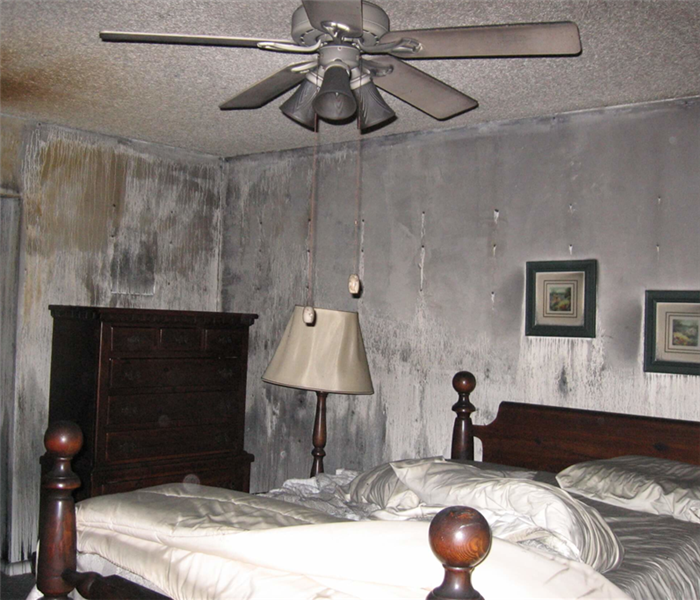 Our SERVPRO team can remove the visible signs and invisible odors from fire.
Our SERVPRO team can remove the visible signs and invisible odors from fire.
Once the flames have been extinguished, you’re left to deal with the smoke and soot that remains. Both are very invasive and can penetrate walls, furniture, clothing and other porous surfaces causing damage and leaving an odor behind.
Smoke can actually flow around plumbing systems and compromise the infrastructure of your home or business. It tends to rise and can cause damage to ceilings, second-stories and attics that may not be very visible. Our professionals know how to find the different types of smoke and thoroughly clean to eliminate them.
There are two different types of smoke, which mean there are 2 different types of residue left behind. wet and dry. Before restoration begins, we test to determine what we are dealing with so that the best cleaning process can be used.
Wet Smoke – Plastic and Rubber - Low heat, smoldering, pungent odor, sticky, oily. Smoke webs are more difficult to clean.
Dry Smoke – Paper and Wood - Fast burning, high temperatures, heat rises, therefore, smoke rises.
Protein Fire Residue – Produced by evaporation of material rather than from a fire - Virtually invisible, discolors paints and finishes, extreme pungent odor.
We certainly hope you never have to deal with fire damage, but we are here to help if it happens. We have the equipment, expertise, experience and empathy to restore your property so that it looks and feels "Like it never even happened."
Have Questions about Fire, Smoke, or Soot Damage?
Call Us Today – 214-522-3000
Preventing Fires in the Fall
10/9/2020 (Permalink)
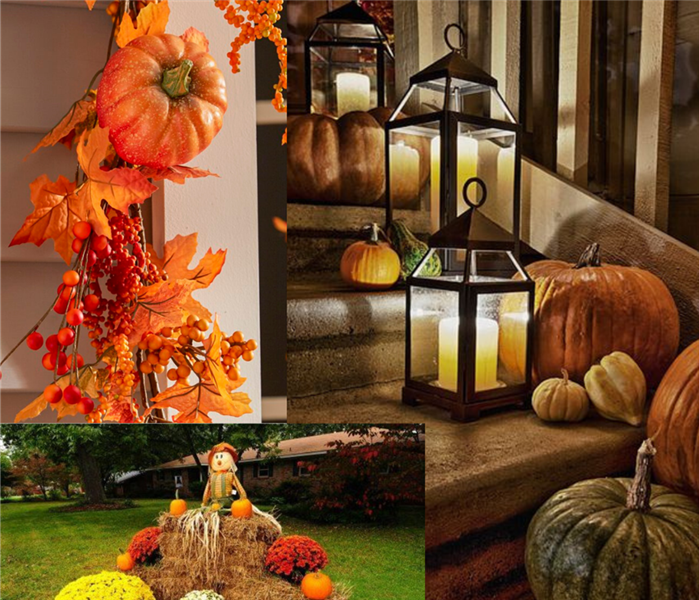 Make sure to keep outdoor fall decor safe from fire risks.
Make sure to keep outdoor fall decor safe from fire risks.
Everyone loves fall in North Texas! The temperature drops a bit, you can buy pumpkin spice everything and it’s a new decorating theme!
Haystacks, dried cornstalks, silly scarecrows, and jack-o-lanterns placed among big pots of mums make fantastic yard décor. But they can also be fire risks so it’s important to be aware and take steps like these to prevent a fall fire in Park Cities.
All jack-o-lanterns should have battery operated candles or glow sticks instead of a live flame.
Any paper or dried vegetable décor should be kept away from heat sources like fire pits, light bulbs or heaters.
When Halloween comes around, make sure the walkways are clear so trick-or-treaters with flowing costumes stay safe.
October is Fire Prevention Month so a great time to check all your smoke alarms to make sure they are working properly and go through your family escape plan once again so everyone knows what to do.
If you don’t have one yet – you can download a template from the National Fire Prevention Association’s website where there you'll find lots of fire safety information and resources for kids.
At SERVPRO of Park Cities, we wish you and your families a fun fall and happy Halloween!
Remember that if anything scary happens we are here around the clock to help.
Park Cities Fire and Water Damage Restoration Company Urges People to Be Careful With Fireworks
6/30/2020 (Permalink)
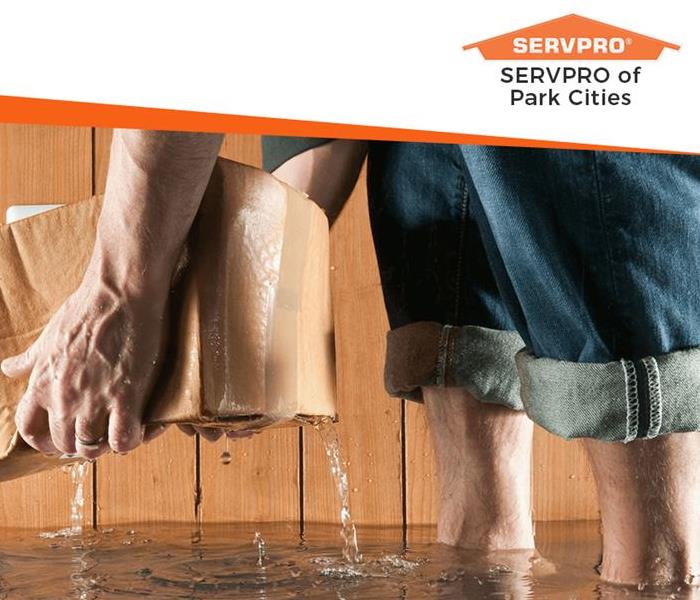 Here to help
Here to help
Summary: SERVPRO of Park Cities urges people to use caution when setting off fireworks.
Celebrating the Fourth of July with fireworks is a deep-rooted American tradition. SERVPRO of Park Cities, a damage restoration company and cleaning service, urges residents of Dallas, University Park, Highland Park, and surrounding areas to use caution when enjoying this tradition.
The first use of fireworks in a July 4th celebration was in Boston, MA, in 1777. Founding father John Adams said he wanted the anniversary of independence to be remembered for years with such things as “bonfires” and “illuminations.” Since the first July 4th fireworks display occurred during the Revolutionary War, some historians think the fireworks were intended as a “morale booster.” Early celebrations would have also included the firing of guns and cannons, adding to the explosive nature of the festivities.
Fireworks Can Be Dangerous
The National Fire Protection Association provides the following fireworks fire and injury statistics to drive home the potential danger that can arise from improperly handling fireworks. “Fireworks started an estimated 19,500 fires in 2018, including 1,900 structure fires, 500 vehicle fires, and 17,100 outside and other fires. These fires caused five deaths, 46 civilian injuries, and $105 million in direct property damage. In 2018, U.S. hospital emergency rooms treated an estimated 9,100 people for fireworks-related injuries; half of those injuries were to the extremities, and 34% were to the eye or other parts of the head. Children younger than 15 years of age accounted for more than one-third (36%) of the estimated 2018 injuries. These injury estimates were obtained or derived from the U.S. Consumer Product Safety Commission’s 2018 Fireworks Annual Report by Yongling Tu and Jason Ng.”
How to Stay Safe When Using Fireworks
Fireworks are a traditional part of many holiday celebrations, but they also can be dangerous. The Texas Department of Insurance offers the following fireworks safety tips.
- Follow local rules.
Some areas allow only certain types of fireworks, and most areas do not allow fireworks within city limits or during burn bans. Follow the local law and contact the local fire officials if there are any questions.
- Find out if a permit is required.
Organizers will need a permit from the local fire department if they are having a fireworks display for a group of fifty or more.
- Hire licensed professionals.
If someone is hired to put on a display for a group, he or she must have a Texas pyrotechnic operator’s license. To find out if an individual has a Texas license, contact the State Fire Marshal’s Office by phone at 1-800-578-4677 or by email at Fire.Marshal@tdi.texas.gov.
- Make sure fireworks are legal in the area.
Fireworks can be sold only at certain times of the year, typically during the week or so leading up to a major holiday. Besides the Fourth of July and New Year’s celebrations, Texas counties may decide to include Texas Independence Day (March 2nd), San Jacinto Day (April 21st), Cinco de Mayo (May 5th), and Memorial Day. Anyone can use fireworks any day of the year as long as they are not banned in the area where they are being used.
- Be safe!
- Children should not use fireworks. Make sure an adult is always watching when children are nearby.
- Remember: Do not mix alcohol and fireworks.
- Follow the firework instructions.
- Do not use fireworks near dry grass, brush, or other flammable materials.
- Never aim fireworks in the direction of a house, person, or animal.
- Have a bucket of water, garden hose, or another water source nearby in
case of emergencies.
Fire and Water Damage Restoration Process
When a home or business is dealing with the aftermath of a fire, the damage that it can cause to the property structure and valuable possessions can be extremely devastating. Here at SERVPRO, the team understands the stress, confusion, and emotions that are present when dealing with this kind of ordeal. The SERVPRO technicians are highly skilled and certified, as well as equipped with fire damage restoration equipment to take special care of the client’s property and possessions. The SERVPRO team will be there with the customer every step along the way to explain the process to help get them through this stressful time.
After the fire trucks leave, the home or business likely suffers from fire and smoke damage and extensive water damage from firefighting efforts. SERVPRO has the specialized fire restoration training needed to restore a home to its pre-fire condition.
Every fire damage event requires a unique solution, but the general process stays the same. The steps listed below illustrate the process for the typical fire damage emergency.
Step 1: Emergency Contact
The restoration process begins when a customer calls SERVPRO. A representative will ask questions regarding the fire damage event that will help SERVPRO respond immediately with the appropriate equipment and resources.
Step 2: Inspection and Fire Damage Assessment
SERVPRO technicians carefully inspect and test adjoining rooms of the property to determine the extent of the fire, smoke, and soot damage. This step is crucial to developing a plan of action.
Step 3: Immediate Board-Up and Roof-Tarp Service
Fire damage can often compromise windows, walls, and roofs. To maintain security and to protect against further damage, the team can board up missing windows and walls and place tarps on damaged roofs.
Step 4: Water Removal and Drying (If Water Damage Is Present)
The water removal process begins almost immediately and removes the majority of the water. SERVPRO technicians then use dehumidifiers and air movers to remove the remaining water and complete the drying process.
Step 5: Removal of Smoke and Soot From All Surfaces
Specialized equipment and techniques are used to remove smoke and soot from ceilings, walls, and other surfaces.
Step 6: Cleaning and Sanitizing
Skilled technicians clean, sanitize, and disinfect all of the restorable items and structures that were damaged by the fire. SERVPRO employs a variety of cleaning techniques to restore belongings to their pre-fire conditions. The SERVPRO specialists are also trained to remove odors using industrial air scrubbers and fogging equipment.
Step 7: Restoration
Restoration is the final step—getting a home or business to its pre-fire condition. Restoration may involve minor repairs, such as replacing drywall, painting, and installing new carpet, or it may entail major repairs such as the reconstruction of various areas or rooms in a home or business.
Conclusion
SERVPRO of Park Cities hopes that everyone’s Fourth of July celebration will be safe, enjoyable, and fire-free. The team of fire and water damage experts is proud to serve the local communities of Dallas, University Park, Highland Park, and surrounding areas.
To learn more about fire and water damage restoration, visit the SERVPRO of Park Cities at https://www.SERVPROparkcities.com. Contact a SERVPRO representative by phone at (214) 522-3000.
Park Cities Kitchen Fire Safety and Awareness
9/27/2019 (Permalink)
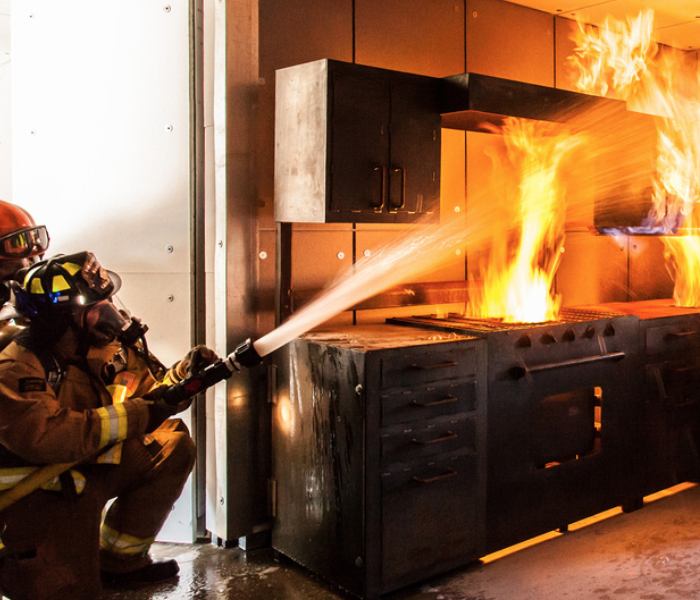 Safety in the kitchen is very important. In the worst case scenarios give SERVPRO a call.
Safety in the kitchen is very important. In the worst case scenarios give SERVPRO a call.
According to the National Fire Protection Association, cooking fires are the number one cause of home fires and home injuries. The leading cause of fires in the kitchen is unattended cooking. Follow these tips to create a safer cooking environment:
- Be alert! If you are tired or have consumed alcohol don’t use the oven or stove.
- Stay in the kitchen while you are frying, grilling, boiling, or broiling food.
- If you are simmering, baking, or roasting food, check it regularly, remain in the kitchen while food is cooking, and use a timer to remind you that you are cooking.
- Keep anything that can catch fire – oven mitts, wooden utensils, food packaging, towels or curtains – away from the stovetop.
- Keep an easily accessible fire extinguisher somewhere in your kitchen.
If you have a cooking fire, consider the following safety protocols to help keep you and your family safe.
- Just get out! When you leave, close the door behind you to help contain the fire.
- Call 911 or the local emergency number after you leave.
- For an oven fire turn off the heat and keep the door closed.
- If you try to fight the fire, be sure others are getting out and you have a clear way out.
- Keep a lid nearby when you are cooking to smother small grease fires. Smother the fire by sliding the lid over the pan and turn off the stovetop. Leave a pan covered until it is completely cooled. Never add water to a grease fire!
If you have experienced a kitchen fire call the professionals at SERVPRO of Park Cities at 214-522-3000
Professional Fire Damage Clean Up- Park Cities
9/6/2019 (Permalink)
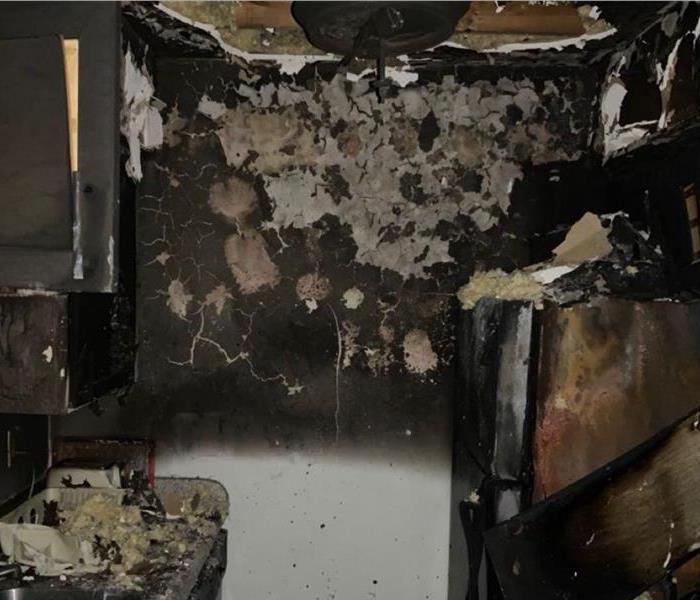 Once the fire is out doesn’t mean you’re safe. Find out what damages the fire left behind before you begin restoration services.
Once the fire is out doesn’t mean you’re safe. Find out what damages the fire left behind before you begin restoration services.
The reasons why professional fire cleanup is crucial focus on safety and thorough remediation in Park Cities as elsewhere. A seemingly minor fire quickly extinguished, might appear to need merely a slightly more intense than usual seasonal cleaning. Taking this perspective is risky, with the potential to expose your loved ones and the structure of your home to invisible yet severe progressive damage.
Significant Water Damage
Merely because it was introduced on purpose to mitigate fire damage in your Park Cities home does not negate the hazards of water damage. Slips and falls, electrical shocks, and permanent harm to building materials are just some of the dangers of firefighting water incursion. Efficient water removal and structural drying are essential before or while soot and other debris are cleared. Our technicians hold multiple certifications from the Institute of Inspection, Cleaning and Restoration Certification (IICRC) and can move between tasks seamlessly.
Safety Concerns When Managing Toxic Residues
Regardless of the extent of the smoke and soot damage, cleaning is a hazardous endeavor. The chemicals, tar, and gasses produced by fire are toxic and abrasive. SERVPRO Fire and Smoke Restoration Technicians (FSRT) are highly-trained in appropriate strategies that clean fire residues efficiently while avoiding smearing and further damage to surfaces by sharp-edged soot particles. We match the type of soot with appropriate cleaners, tools, and methods based on research and experience, not trial and error.
Specialized Professional Equipment
SERVPRO technicians don personal protective equipment (PPE) when evaluating and cleaning your home. We frequently contain the work area with heavy-duty plastic sheeting and by operating a negative pressure air scrubber. The pressure seals the partition and forces airborne contaminants through HEPA filters before exhausting outside.
Pack-Out Possibilities
The contents of your home suffer from smoke, smells, and soot, too. We offer a Contents Claim Inventory Service (CCIS) to document any items we remove for assessment, cleaning, deodorization, and other restorative procedures at our production facility. Our talented Contents Processing Technicians (CPT) employ a broad range of strategies to save personal possessions you feared ruined beyond repair.
SERVPRO of Park Cities offers victims of fire damage a comprehensive array of professional mitigation and remediation services. Partner up with our skilled and certified team by scheduling an assessment at. (214)-522-3000
Park Cities Fire Odor Removal. Sometimes it’s inside the walls.
9/6/2019 (Permalink)
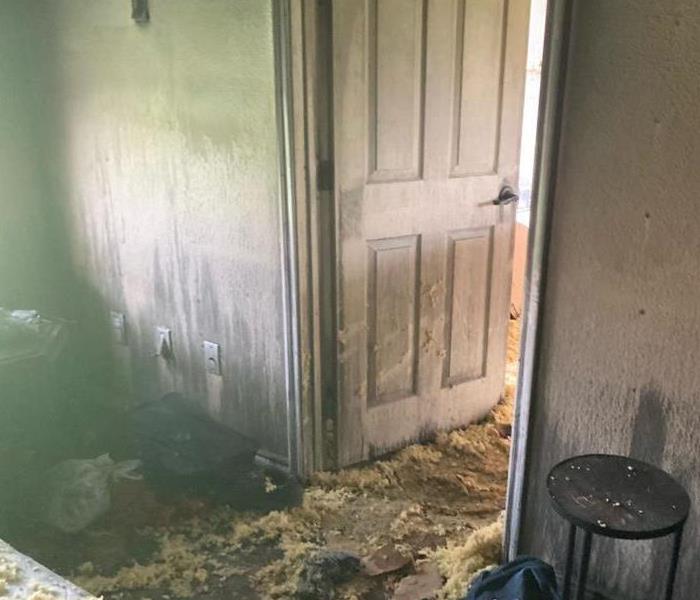 SERVPRO can assist in removing the damage from outside as well as inside the walls. #Likeitneverhappened
SERVPRO can assist in removing the damage from outside as well as inside the walls. #Likeitneverhappened
Recovering from a fire disaster is a many-phase process in Park Cities. Our highly-qualified fire mitigation team takes the process step by step, ensuring we miss nothing in our quest to make your fire crisis “Like it never even happened.” From water and chemical removal because of firefighting efforts to customized residue cleaning and charring restoration, we handle all necessary tasks safely and professionally.
Lingering smoke smells make the removal of fire odor in your Park Cities home very important. No matter how untouched your dwelling looks after our team finishes surface cleaning and damage restoration, the unmistakable odor of the combusted building materials and contents brings back unpleasant and perhaps terrifying memories.
SERVPRO fire remediation crew members approach odor removal systematically, following protocols learned during Institute of Inspection, Cleaning, and Restoration Certification (IICRC) training. We start by removing the burned materials, including scraping down charred structural materials to undamaged layers. A thorough cleaning removes many of the odor-bearing residues. If a smell continues to emanate from a cleaned surface, we might consider sealing with appropriate professional products.
HVAC systems can spread and retain odor-bearing particles. If vents are open during the fire or fire residue cleaning efforts, the odors drift far from the fire site. At a minimum, filters need changing, and the system needs to be turned off for evaluation. SERVPRO experts inspect the ductwork to see if cleaning or sealing is indicated and make arrangements to complete that service.
Airborne soot particles and those that settle on surfaces and furnishings are tiny yet pack a pungency that must be addressed. SERVPRO crews prefer to use techniques and equipment that eliminate the odors rather than covering them with distracting perfumes. Thermal foggers recreate the conditions of the fire to disperse heated chemicals that attach to the granular bits and neutralize the smell. We also use hydroxyl generators or ozone machines as another way to attack the odor problem at a molecular level. Enzymatic products can help with organic soiling and smells.
Rely on the team at SERVPRO of Park Cities to eliminate the smoky odors that might otherwise remain in your home even after fire remediation. Call us at (214)-522-3000 to get the process of odor abatement rolling.
Click here for more information Park Cities.
Heat Safety For You & Your Home
5/1/2018 (Permalink)
As summer approaches, it is time to consider precautions for the extreme Texas heat we are sure to experience in the coming months. On top of being a concern for safety, heat can also cause severe damage to homes in a variety of ways. Urban area residents have a greater chance of being affected than those who live in rural areas due to the heat island effect – increased temperatures in highly populated areas due to large amounts of concrete. To be better prepared for the impact of heat on both your health and your home read the following information:
Protecting Yourself
Whether you are in an urban or rural area, there are several things you can do to prepare for and prevent extreme heat from affecting you. If possible, stay indoors in air conditioning. Be sure to check on your pets who may be outdoors or bring them inside. Stay hydrated and limit alcohol and caffeine intake.
If you must go outside, wear loose-fitting, light-colored clothing, and be sure to apply sunscreen often. Pay attention to signs of heat exhaustion, which are heavy sweating; weakness; cold, pale, and clammy skin; nausea or vomiting; fainting, according to the Center for Disease Control and Prevention (CDC). Heat exhaustion can lead to heat stroke, which is life-threatening. Signs of heat stroke are a high body temperature (103+), rapid and strong pulse, and possible unconsciousness. If you think someone has heat stroke, call 911 immediately and move the person somewhere cool. Reduce body temperature with cool, wet cloths, or a bath. Do not give a person with heat strokes fluids, and treat the situation as a serious medical emergency (CDC).
Protecting Your Home
In a place like Dallas roof damage can be expected. We have heavy hail storms that are not kind to the roofing on our homes; however, many people don’t realize that it is the months of high temperatures we experience that wear our roofs down quickly. Heat can shrink shingles, causing nails to pop and those shingles to lift. Rafters and joists may start to expand which leads to sealant stretching and breaking. Even the heat rising within your home into your attic can result in blistered and cracked shingles.
These things are bad news for your home as we obviously rely on the roof to protect it from all types of weather, particularly the down pours from summer storms. To try and decrease the impact of the heat this summer on your own roof you can install an attic fan, more insulation, or even ridge vents to attempt to alleviate some of the damage. Professional roofers can assess the damage on your roof, and give you further suggestions on maintaining it.
Extreme Heat
Extreme heat is a serious concern for both the safety of humans and homes. If you experience any damage to your home due to a damaged roof, call SERVPRO of Park Cities right away to get your home back to normal as quickly as possible. Call us anytime at 214-55-3000.
What To Do After a Fire: Dealing With the Damage
3/20/2018 (Permalink)
From the first call to 911 to calling in a remediation team, dealing with a fire is extremely overwhelming and stressful. After the fire has been put out it can be hard to know what your next steps should be, so here are a few tips on what you can do to get your life and home back to normal as quick as possible.
1. Call in your local SERVPRO remediation specialists. A fire can result in multiple types of damage to your home or business, including water, so call in the professionals who have years of experience in all realms of restoration.
2. Call your insurance agent in order to get your insurance claim rolling, and to find out important information such as coverage provisions, emergency housing options, etc. If you are a tenant, call your landlord so that they know to get in touch with their insurance agent.
3. Do not enter the home until a fire fighter has assured it is safe for you to do so. Once inside try to limit your movement around the home so soot particles are not spread or embedded. Also avoid touching anything to avoid soiling previously clean areas.
4. Carefully move any undamaged items that are at risk in the effected area (i.e. television at risk for water damage) to a safe zone if possible.
Our SERVPRO professionals will be onsite within just a couple of hours after a call to begin the cleanup. We work with insurance agents to ensure that people get their homes or businesses back to normal as quickly as possible. If you experience a fire, do not hesitate to call SERVPRO of Park Cities at 214-522-3000 anytime of the day or night.
Understanding the Behavior of Smoke
5/31/2017 (Permalink)
The damage to your property following a fire can often be complicated due to the unique behavior of smoke. There are two different types of smoke – wet and dry. As a result, there are different types of soot residue after a fire, SERVPRO of Park Cities Professionals are thoroughly trained in fire cleanup and restoration and know the different types of smoke and their behavior patterns. Knowing this information is vital to proper restoration. Before restoration begins, SERVPRO of Park Cities Professionals will survey the loss to determine the extent of impact from fire, smoke, heat, and moisture on the building materials and contents. The soot will then be tested to determine which type of smoke damage occurred. Pretesting determines the proper cleaning method and allows SERVPRO of Park Cities to focus on saving your precious items.
SERVPRO of Park Cities Professionals know smoke can penetrate various cavities within the structure, causing hidden damage and odor. Their knowledge of building systems helps them investigate how far smoke damage may have spread. The following are additional facts you may not know about smoke.
- Hot smoke migrates to cooler areas and upper levels of a structure.
- Smoke flows around plumbing systems, seeping through the holes used by pipes to go from floor to floor.
- The types of smoke may greatly affect the restoration process.
Different Types of Smoke
Wet Smoke (Plastic and Rubber)
Low heat, smoldering, pungent odor, sticky, smeary. Smoke webs are more difficult to clean.
Dry Smoke (Paper and Wood)
Fast burning, high temperatures, heat rises therefore smoke rises.
Protein Fire Residue (Produced by evaporation of materials rather than from a fire)
Virtually invisible, discolors paints and varnishes, extreme pungent odor.
Fuel Oil Soot (Furnace Puff Backs)
While “puff backs” can create havoc for homeowners, SERVPRO of Park Cities Professionals can, in most cases, restore the contents and structure quickly.
Other Types (Tear gas, fingerprint powder and fire extinguisher residue)
Special loss situations require special care.
SERVPRO of Park Cities Professionals are trained to handle even the toughest losses. If your home or business suffers fire or smoke damage, contact us, at 214-522-3000, to help make it “Like it never even happened.”
Celebrate Safely with a Recipe for Safety
5/31/2017 (Permalink)
Each holiday season, families gather to celebrate by preparing delicious feasts, but if you don’t practice safe cooking habits, your holiday could become hazardous very quickly. According to the National Fire Protection Association, cooking fires are the number one cause of home fires and home injuries. The leading cause of fires in the kitchen is unattended cooking. It’s important to be alert to prevent cooking fires.
- Be alert! If you are sleepy or have consumed alcohol don’t use the stove or stovetop.
- Stay in the kitchen while you are frying, grilling, boiling, or broiling food.
- If you are simmering, baking or roasting food, check it regularly, remain in the kitchen while food is cooking, and use a timer to remind you that you are cooking.
- Keep anything that can catch fire – oven mitts, wooden utensils, food packaging, towels or curtains – away from the stovetop.
If you have a cooking fire, consider the following safety protocols to help keep you and your family safe.
- Just get out! When you leave, close the door behind you to help contain the fire.
- Call 911 or the local emergency number after you leave.
- For an oven fire turn off the heat and keep the door closed.
- If you try to fight the fire, be sure others are getting out and you have a clear way out.
- Keep a lid nearby when you are cooking to smother small grease fires. Smother the fire by sliding the lid over the pan and turn off the stovetop. Leave a pan covered until it is completely cooled.
SERVPRO of Park Cities Professionals wish you a safe a happy holiday season.
Smoke Alarms Save Lives
5/31/2017 (Permalink)
Smoke alarms play a vital role in saving lives, and when properly installed, can reduce the risk of fire injury in half.
The National Fire Protection Association recommends smoke alarms be installed in every bedroom, outside all sleeping quarters and on every level of the house. Business owners should consult the local Fire Marshall to ensure specific building fire codes and smoke detector requirements are met.
Smoke alarms work best when paired with a fire escape plan. A plan allows your family, employees or clients to escape quickly and safely in an emergency situation.
Review the following tips regarding smoke detectors installation and maintenance. For more on emergency preparedness, contact SERVPRO of Park Cities at 214-522-3000.
- Install smoke alarms on every level of the home, including the basement.
- Smoke alarms should be installed away from kitchen to prevent false alarms. Generally, they should be at least 10 feet from a cooking appliance.
- Test smoke alarms at least once a month using a test button.
- Replace batteries in all smoke alarms at least once a year. If an alarm “chirps,” the battery is low and should be replaced right away.
- Replace all smoke alarms when they are 10 years old.
Extreme Heat
5/22/2017 (Permalink)
As summer approaches, it is time to consider safety precautions for extreme heat in the coming months. Heat affects all people, but especially the young, elderly, sick and overweight. Urban area residents also have a greater chance of being affected than those who live in rural areas due to the heat island effect.
According to the EPA, "the sun can heat dry, exposed urban surfaces, such as roofs an pavements, to temperatures 50-90 degrees F hotter than the air, while shaded or moist surfaces - often in more rural surroundings - remain close to air temperatures." These surface heat islands are strongest during the day when the sun is shining, while the atmospheric heat islands are more likely after sunset "due to the slow release of heat from urban infrastructure."
Whether you are in an urban or rural area, there are several things you can do to prepare for and prevent extreme heat from affecting you. If possible, stay indoors in air conditioning. Be sure to check on your pets who may be outdoors or bring them inside. Stay hydrated and limit alcohol and caffeine intake.
If you must go outside, wear loose-fitting, light-colored clothing, and be sure to apply sunscreen often. Pay attention to signs of heat exhaustion, which are heavy sweating; weakness; cold, pale, and clammy skin; nausea or vomiting; fainting, according to the Center for Disease Control and Prevention (CDC). Heat exhaustion can lead to heat stroke, which is life-threatening. Signs of heat stroke are a high body temperature (103+), rapid and strong pulse, and possible unconsciousness. If you think someone has heat stroke, call 911 immediately and move the person somewhere cool. Reduce body temperature with cool, wet cloths or a bath. Do not give a person with heat strokes fluids, and treat the situation as a serious medical emergency (CDC).
If you live in a humid climate, be aware of the heat index. The heat index factors in the humidity, which can make the temperature feel 15 degrees hotter.
Extreme heat is a serious danger. For more information on preparation and prevention, visit ready.gov or cdc.gov.
Park Cities / Garland Smoke & Soot Cleanup
4/11/2016 (Permalink)
Smoke and soot is very invasive and can penetrate various cavities within your home, causing hidden damage and odor. Our smoke damage expertise and experience allows us to inspect and accurately assess the extent of the damage to develop a comprehensive plan of action.
Smoke and Soot facts:
- Hot smoke migrates to cooler areas and upper levels of a structure.
- Smoke flows around plumbing systems, leaking through the holes used for pipes to go from floor to floor.
- The type of smoke may greatly affect the restoration process.
Different Types of Smoke
There are two different types of smoke–wet and dry. As a result, there are different types of smoke residue after a fire. Before restoration begins, SERVPRO of Park Cities / North Garland will test the soot to determine which type of smoke damage occurred. The cleaning procedures will then be based on the information identified during pretesting. Here is some additional information:
Wet Smoke – Plastic and Rubber
- Low heat, smoldering, pungent odor, sticky, oily. Smoke webs are more difficult to clean.
Dry Smoke – Paper and Wood
- Fast burning, high temperatures, heat rises, therefore, smoke rises.
Protein Fire Residue – Produced by evaporation of material rather than from a fire
- Virtually invisible, discolors paints and finishes, extreme pungent odor.
Our Fire Damage Restoration Services
Since each smoke and fire damage situation is a little different, each one requires a unique solution tailored for the specific conditions. We have the equipment, expertise, and experience to restore your fire and smoke damage. We will also treat your family with empathy and respect and your property with care.
Have Questions about Fire, Smoke, or Soot Damage?
Call Us Today – 214-522-3000






 24/7 Emergency Service
24/7 Emergency Service














